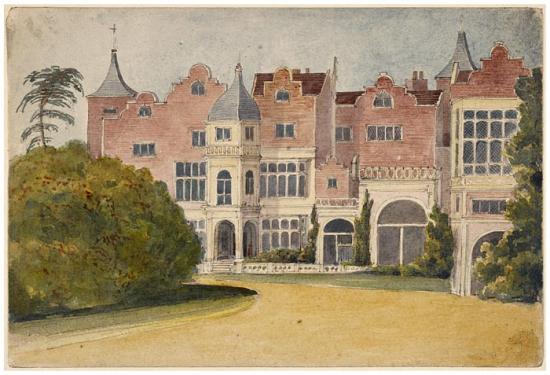
Holland House, Kensington
Gift of Charles Ryskamp
"The Little Card I will do as soon as Possible but when you Consider that I have been reduced to a Skeleton from which I am slowly recovering you will I hope have Patience with me."
–William Blake, April 1827
Blake and Cumberland's friendship dated from their youth at the Royal Academy. Cumberland became an amateur artist, reviewer, and writer on artistic subjects. His son, a student of John Linnell, was responsible for the important introduction of his teacher to Blake.
Holland House had been built about 1607 for Sir Walter Cope. By 1816 it was the home of Henry Richard Fox, third Baron Holland. It became the center of liberal political gatherings and intellectual and cultural activity, where aspiring artists and writers mingled with government and political figures. Cumberland used a rich tonal palette and dynamic contours to capture the building's elaborate horizontal facade.
Blake's plate for Cumberland's card was delivered by his widow.
William Blake (1757–1827) occupies a unique place in the history of Western art. His creativity included both the visual and literary arts. In his lifetime he was best known as an engraver; now he is also recognized for his innovative poetry, printmaking, and painting. Blake's keen perception of the political and social climate found expression throughout his work. His strong sense of independence is evident in the complex mythology that he constructed in response to the age of revolution.
Blake was already recognized as an engraver at age twenty-five, when his first volume of poems appeared. At thirty-three, in The Marriage of Heaven and Hell, he audaciously claimed that his birth had marked the origin of a "new heaven" in which his own art would exemplify the creativity prefigured by Milton and Michelangelo. By that time, Blake, in one of his most productive periods, had already produced Songs of Innocence and was at work on a series of illuminated books. In 1818 he met John Linnell, a young painter and engraver, through whom a group of young artists became Blake's followers. Calling themselves the Ancients, they helped perpetuate Blake's influence for generations.
The Morgan's Blake collection—one of this country's most distinguished—began with purchases as early as 1899 by Pierpont Morgan. During the tenure of Charles Ryskamp, director from 1969 to 1986, major gifts almost doubled the size of its Blake holdings. In recent years Ryskamp's own gifts of engravings, letters, and related materials have significantly enriched its scholarly resources.
This online exhibition is presented in conjunction with the exhibition William Blake's World: "A New Heaven Is Begun" on view September 11, 2009, through January 3, 2010.
This exhibition is made possible through the generosity of Fay and Geoffrey Elliott.
